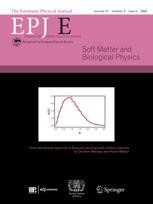‘Bottom-heavy squirmers’ adopt characteristic group behaviours
Simulated particles which mimic the behaviours of self-propelling microorganisms have distinct collective properties which depend on their velocities and bottom-heaviness.
New York | Heidelberg, 27 May 2020
 From starling aberrations to self-turbulent fluids, ‘active systems’ encompass a wide family of phenomena in which individual objects propel themselves forward, allowing them to display intriguing collective behaviours. On microscopic scales, they are found in groups of living organisms which move around by squirming, and are aligned with Earth’s gravitational fields due to their bottom-heavy mass distributions. Through research published in EPJ E, Felix Rühle and Holger Stark at the Technical University of Berlin find that depending on their properties, these objects collectively spend most of their time in one of two states, between which some intriguing behaviours can emerge.
From starling aberrations to self-turbulent fluids, ‘active systems’ encompass a wide family of phenomena in which individual objects propel themselves forward, allowing them to display intriguing collective behaviours. On microscopic scales, they are found in groups of living organisms which move around by squirming, and are aligned with Earth’s gravitational fields due to their bottom-heavy mass distributions. Through research published in EPJ E, Felix Rühle and Holger Stark at the Technical University of Berlin find that depending on their properties, these objects collectively spend most of their time in one of two states, between which some intriguing behaviours can emerge.
The duo’s insights could help to explain the mysterious properties of some groups of microorganisms, including thin films of phytoplankton which are sometimes found in coastal regions, and algae which form ‘dancing’ clumps. They found that these collective behaviours are determined by the ability of the self-propelling objects to swim upwards against the gravitational force, and their degrees of bottom-heaviness. For lower values of these quantities, groups of swimmers will sink to the bottom of their container just like inactive dust grains; but for higher values, will instead collect at the top. In between these states, smaller clusters of swimmers group at the bottom, which are fed by plumes of sinking particles. Also, porous clusters of swimmers can form, which allow individual particles to escape.
Rühle and Stark made their discoveries using computer simulations involving around 900 bottom-heavy squirmers in a fluid. Through their advanced techniques, they were able to account for any interactions between the swimmers, as well as the properties of the fluid itself. The duo’s results now offer fascinating new insights into the properties of active systems under the influence of gravity, and could help biologists to better understand the roles of certain microorganisms in natural ecosystems.
References: F Rühle, H Stark (2020), Emergent collective dynamics of bottom-heavy squirmers under gravity, Eur. Phys. J. E 43:26. DOI 10.1140/epje/i2020-11949-8
Further Information
For more information visit: www.epj.org
Services for Journalists
The full-text article is available here.
Contact
Sabine Lehr | Springer | Physics Editorial Department
tel +49-6221-487-8336 | sabine.lehr@springer.com
